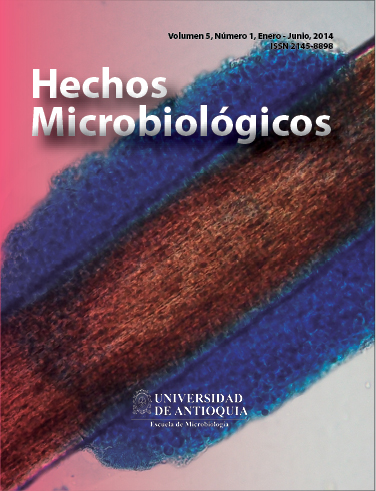Potenciadores en el proceso de remoción biológica de Hidrocarburos Aromáticos Policíclicos (PHAS)
DOI:
https://doi.org/10.17533/udea.hm.323248Palabras clave:
biodegradación, hidrocarburos aromáticos policíclicos, potenciador, suelosResumen
Introducción: Los hidrocarburos aromáticos policíclicos (HAP) son un tipo de contaminantes ambientales, formados a partir de la ignición incompleta de los combustibles fósiles, durante eventos naturales y/o actividades humanas; por tanto están siendo constantemente acumulados en el ambiente. La principal forma de eliminar estos HAP es mediante la biorremediación a partir de la capacidad de microorganismos para degradar compuestos altamente tóxicos y recalcitrantes. Los procesos de biorremediación pueden verse intensificados mediante la implementación de potenciadores, los cuales son sustancias o compuestos que apoyan las técnicas de remediación usadas actualmente mejorando los resultados obtenidos.
Objetivo: Describir los potenciadores implementados en la degradación biológica de HAP a partir de la literatura científica.
Materiales y métodos: Se realizó una revisión sistemática de la literatura científica de los últimos 10 años. La búsqueda se realizó en las bases de datos Springerlink y en el metabuscador ScienceDirect, se empleó la ruta de búsqueda (biodegradation AND (Polycyclic Hydrocarbons Aromatic OR PHA) AND enhancer AND soil).
Resultados: Se obtuvieron 22 artículos para la realización de la revisión sistemática, 15 de Sciencedirect y 7 de Springer, y se complementaron con 1 tesis de maestría y un artículo de revista no indexada. Se describen los diferentes potenciadores reportados, su naturaleza, usos y porcentajes de potenciación de la acción biorremediadora.
Conclusiones: El uso de nitrógeno y algunos tipos de microorganismos generan un aumento en el efecto bioremediador de los PHAs.
Descargas
Citas
Torres K, Zuluaga T. Biorremediación de suelos con-taminados por hidrocarburos. Medellín: Universidad Nacional de Colombia; 2009.
Machin D, Morales D, Martínez F, Okoh A, Trejo M.Benzo[a]pyrene removal by axenic- and co-cultures of some bacterial and fungal strains. International Biode-terioration and Biodegradation 2010; 64 (7): 538-544.
Piskonen R, Merja I. Evaluation of chemical pre-treatment of contaminated soil for improved PAH bio-remediation. Applied Microbiology and Biotechnolo-gy 2004; 65(5): 627-634.
Ruihong Y. Bioremediation of Polycyclic Aromatic Hydrocarbon (PAH) Contaminated Soils in a Roller Baffled Bioreactor. Tesis de maestría. University of Sas-katchewan; Saskatoon, Saskatchewan; 2006.
Cheng K, Wong J. Combined effect of nonionic sur-factant Tween 80 and DOM on the behaviors of PAHs in soil–water system. Chemosphere 2006; 62(11): 1907-1916.
Ruixia H, Anhuai L. Biodegradation of heavy oils by halophilic bacterium. Progress in Natural Science 2009: 19(8): 997-1001.7. Garbisu C, Amézaga I, Alkorta I. Biorremediación y Ecología. Ecosistemas 2002; 3: 1-2.
Kobayashi T, Murai Y, Tatsumi K, Limura Y. Biode-gradación of polycyclic aromatic hydrocarbons by Sphingomonas sp. enhanced by water-extractable organic matter from manure compost. Science of The Total Environment 2009; 407(22): 5805-5810.
Martínez-Checa F, Toledo F, El Mabrouki K, Que-sada E, Calvo C. Characteristics of bioemulsifier V2-7 synthesized in culture media added of hydrocarbons: Chemical composition, emulsifying activity and rheo-logical properties. Bioresource Technology 2007; 98: 3130-3135.
Riser-Roberts E. Remediation of Petroleum Contami-nated Soils: Biological, Physical, and Chemical Proces-ses. Florida: Lewis Publishers; 1998.
Jiménez BE. La contaminación ambiental en México. Causas, efectos y tecnología apropiada. México: Cole-gio de ingenieros ambientales de México, A.C., Insti-tuto de Tecnología de la UNAM, FEMISCA; 2001
Acuña-Arias F. Química Orgánica. Costa Rica: Edito-rial Universidad Estatal a Distancia; 2006.
Organización Marítima Internacional. Organiza-ción Marítima Internacional. Manual sobre la conta-minación ocasionada por hidrocarburos. Parte 4: lu-cha contra los derrames de hidrocarburos. Segunda edición. Londres: OMI; 2005.
Corona L, Iturbe R. Atenuación natural en suelos contaminados con hidrocarburos. Ingeniería. Investi-gación y Tecnología 2005; 6(2): 119-126.
Ortíz E, Núñez R, Fonseca E, Oramas J, Almazán V, Cabranes Y, Miranda A, et al. Biorremediación de suelos contaminados con hidrocarburos. Revista Contribución a la Educación y la Protección del Medio Ambiente. (6): 51-60.
Zhang J, Lin X, Liu W, Wang Y, Zeng J, Chen H. Effect of organic wastes on the plant-microbe remediation for removal of aged PAHs in soils. J Environ Sci 2012; 24(8): 1476-1482.
Bertin L, Capodicasa S, Occulti F, Girotti S, Mar-chetti L, Fava F. Microbial processes associated to the decontamination and detoxification of a polluted activated sludge during its anaerobic stabilization. Water Research 2007; 41(11): 2407-2416
Pizzul L, Castillo M, Stenström J. Characterization of selected actinomycetes degrading polyaromatic hydrocarbons in liquid culture and spiked soil. World J Microbiol Biotechnol 2006; 22(7): 745-722.
Ferrera R, Rojas N, Poggi H, Alarcón A,Cañizares R. Procesos de biorremediación de suelo y agua con-taminados por hidrocarburos del petróleo y otros compuestos orgánicos. Rev Latinoam Microbiol 2006; 48(2): 179-187
Franzetti A, Caredda P, Ruggeri C, La Colla P, Tam-burini E, Papacchini M, et al. Potential applications of surface active compounds by Gordonia sp. strain BS29 in soil remediation technologies. Chemosphere 2009; 75(6): 801-807
Roy S, Hens D, Biswas D, Biswas D, Kumar R. Survey of petroleum-degrading bacteria in coastal waters of Sunderban Biosphere Reserve. World J Microbiol Bio-technol 2002; 18(6): 575–581.
Kyung-Hee S, Kyoung-Woong K, Yeonghee A. Use of biosurfactant to remediate phenanthrene-conta-minated soil by the combined solubilization–biode-gradation process. J Hazard Materials 2006; 137(11): 1831-1837
Navarro R, Limura Y, Ichikawa H, Tatsumi K.Treatment of PAHs in contaminated soil by extraction with aqueous DNA followed by biodegradation with a pure culture of Sphingomonas sp. Chemosphere 2008; 73(9): 1414-1419.
Toledo F, Calvo C, Rodelas B, González-López J.Selection and identification of bacteria isolated from waste crude oil with polycyclic aromatic hydrocar-bons removal capacities. Systematic and Applied Mi-crobiology 2006; 29(3): 244-252.
Trably E, Patureau D. Successful Treatment of Low PAH-Contaminated Sewage Sludge in Aerobic Bio-reactors (7 PP). Environmental Science and Pollution Research 2006; 13(3): 170-176
Cajthaml T, Erbanová P, Kollmann A, Novotný Č, Šašek V, Mougin C. Degradation of PAHs by ligni-nolytic enzymes of Irpex lacteus. Folia Microbiologica 2008; 53(4): 289-294.
Dhenain A, Mercier G, Blais JF, Chartier M. Com-bined column and cell flotation process for the treatment of PAH contaminated hazardous was-tes produced by an aluminium production plant. J Hazard Materials 2009; 165(1-3): 394-407
Sánchez J, Rodríguez JL. Biorremediación: Funda-mentos y aspectos microbiológicos. Industria y Mine-ría 2003; 351: 17-21.
Maroto E, Quesada R. Procesos de evolución de la descontaminación “in situ” de suelos afectados por hidrocarburos. Tesis doctoral. Universidad Politécnica de Madrid; 2003.








